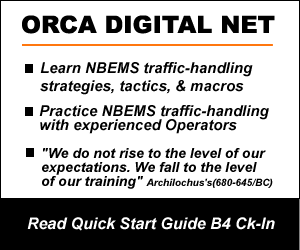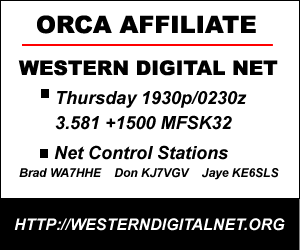ORCA DIGITAL NET
ORCA DIGITAL NET
ORCA DIGITAL NET is dedicated to learning and practicing digital traffic-handling skills. To support our mission, we focus on three fundamentals: Directed Net protocols, Computer skills, and digital traffic-handling with NBEMS software. Directed Net protocols are essential for orderly digital communications, especially on HF. Doubles are the bane of digital net operations. Unlike CW and Phone, digital doubles usually scramble both signals and nothing is copied. On Directed Nets, all transmissions go through NCS.
Digital operations require familiarity with PC operating systems and file management. Basic typing skills are important too. Handling digital traffic often involves file manipulation and editing. Computer skills are basic to learning, configuring, and operating digital software. Of the NBEMS software suite developed by Dave Freese W1HKJ, we use FLDIGI, FLMSG, & FLAMP every session. The FLDIGI suite of applications is a world-class digital messaging system, used by many agencies and governments around the world.
If you’re interested in learning to pass digital traffic in emergencies, or just expand your knowledge of digital operations, ORCA may be right for you. Read our Quick-Start Guide and monitor the net. NCS controls net operations; you can learn a lot about digital traffic-handling by simply observing net operations. Our members are the actual Instructors. Many of them have been with us for years. They’re digital veterans that continue to work the net because they value the opportunity to practice their skills. Their participation creates a weekly working model. Observing them will teach you digital networking and traffic-handling. This website outlines what you need to know and what to expect from the net. It also outlines what’s expected of you. In brief, you need to learn and follow a simple set of Protocols that define software settings, Check-In, and net operations. As a Training net, we’re error tolerant; that said, we expect you to do your homework, pay attention, and do your best.
To participate in NBEMS Exercises, you must learn the routine while Monitoring or Lurking. Ck-In QNX and work NBEMS Exercises silently, without the time pressure of Active participation. The after-net Monitor’s Session enables Monitoring stations and lurkers to Fill or CONFIRM Exercise files. Read the Quick-Start Guide carefully. All you need to know is there. Then, Monitor a session or two and read the Quick-Start Guide again.
NCS: Doug K7KY
NCS: Mindy W7ZAP





